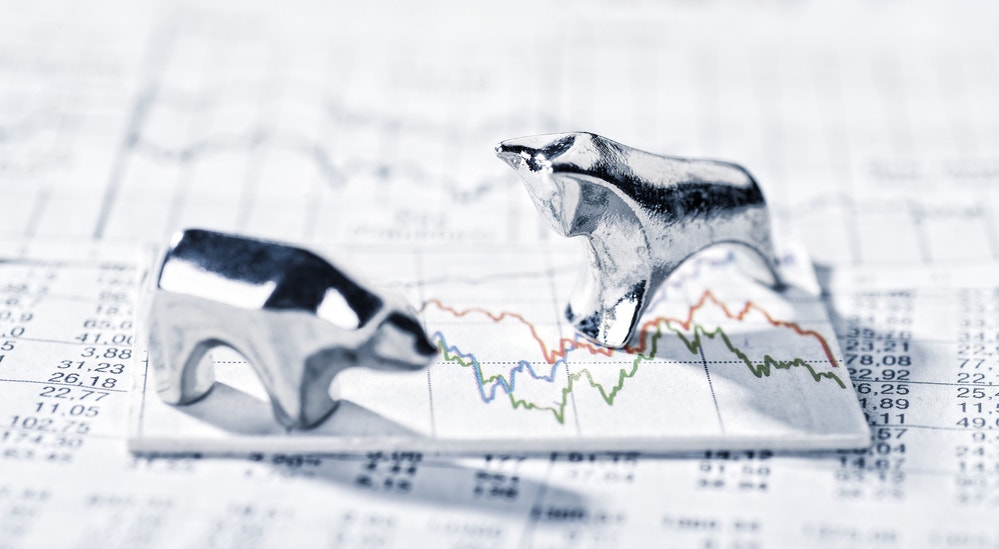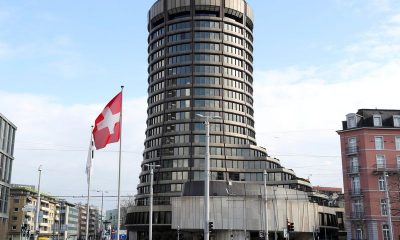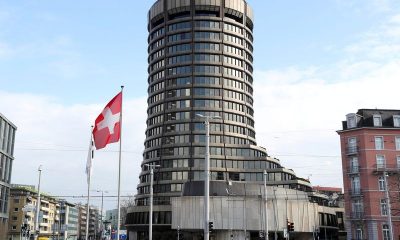Economy
Stocks Fall, Ending S&P 500’s Winning Streak, While Dollar Gains On Safe-Haven Flows: What’s Driving Markets Friday?

Friday was a bad day for U.S. stocks, with the S&P 500 on track to end the week in the red, making it the worst week since the banking crisis in mid-March and putting an end to a five-week winning run.The U.S. dollar, Treasuries and gold all gained some ground, indicating a boost in safe haven demand amid a sell-off in risky assets. Among sectors, technology and energy were the worst performers.June flash PMIs for the U.S. revealed the services sector remained robust last month, but manufacturing fell by the greatest degree that it has this year, far more than projected.Despite the recent slowing in inflation and softening in economic activity, Fed Chair Jerome Powell made hawkish remarks this week during his testimony before Congress, opening the door to two more rate hikes this year. Key Highlights From Friday’s Trading:Every major U.S. stock market index lost ground Friday and was set to finish the week in the red.The S&P 500 and the Nasdaq 100 fell 0.5% and 0.8%, respectively. Both indexes were down 1.2% for the week.The blue-chip Dow Jones 30 Index dropped 0.5% on Friday and 1.5% for the week.Small caps in the Russell 2000 fell 0.7% today, and 2.3% this week. U.S. Indices’ Performance on FridayIndex Performance (+/-)ValueNasdaq 100-0.76%14,954.53S&P 500 Index-0.51%4,365.86Dow Industrials-0.45%33,794.19Russell 2000-0.86%1,832.17Analyst Color:The major indices are up solidly so far this month. Going by historical performance, an analyst sees this as positive for the market.Carson Group’s Ryan Detrick noted that when the S&P 500 is up between 10%-15% for the six months ended in June, the index has advanced for the rest of the year 12 out of 12 times. With six sessions to go before the end of the first half, the S&P 500 is up 14.13%.More importantly, the median gain is about 11%, Detrick said. The average year median gain for the final six months has been 5%, he added.Friday’s Trading In Major US Equity ETFs: In midday trading on Friday, the SPDR S&P 500 ETF Trust SPY was 0.5% lower to $434, the SPDR Dow Jones Industrial Average ETF DIA fell 0.44% to $337 and the Invesco QQQ Trust QQQ was 0.6% lower to $364, according to Benzinga Pro data.All U.S. equity sectors were negative. The underperformers were the Utilities Select Sector SPDR Fund XLU, the Energy Select Sector SPDR Fund XLE and the Technology Select Sector SPDR Fund XLK, down by 1%, 0.9% and 0.7%, respectively. Latest Economic Data:According to preliminary estimates, the S&P Global US Manufacturing PMI fell to 46.3 in June 2023, indicating the largest contraction in the manufacturing sector since December, compared to 48.4 in May and projections of 48.5.The S&P Global US Services PMI ticked down from 54.9 in May to 54.1 in June, slightly better than expectations of 54.See also: Futures Trading: Best Futures To TradeStocks In Focus:
Smith & Wesson Brands, Inc. SWBI shares rallied by 18% following a stronger-than-expected financial results last quarter.
Virgin Galactic Holdings, Inc. SPCE tumbled by nearly 20% following company’s announcement to sell an additional $400 million in shares for investments in spaceship fleet and infrastructure for commercial space operations.
CarMax, Inc. KMX rose 8.5% after reporting better-than-expected results.
Coinbase Global, Inc. COIN rose 5% on the back of a broad-based crypto rally.
Commodities, Bonds, Other Global Equity Markets: Crude oil fell 1%, with a barrel of WTI-grade crude dropping to $68. The United States Oil Fund ETF USO was 0.7% lower to $62 per share. Treasury yields fell slightly, with the 10-year yield down by 4 basis points to 3.75% and the two-year yield down by 1 basis point to 4.63%. The iShares 20+ Year Treasury Bond ETF TLT was 0.9% higher for the day. The dollar rose, with the U.S. dollar index, which is tracked by the Invesco DB USD Index Bullish Fund ETF UUP, up 0.6%. The EUR/USD pair, which is tracked by the Invesco CurrecyShares Euro Currency Trust FXE, was 0.6% lower to 1.089.European equity indices closed in the red. The SPDR DJ Euro STOXX 50 Etf FEZ fell 1.3%. Gold ticked 0.2% to $1,918/oz. The SPDR Gold Trust GLD was 0.3% higher to $178. Silver rose 0.4% to $22.3, with the iShares Silver Trust SLV down 0.2% to $20. Bitcoin BTC/USD was 4% higher to $31,110. Staff writer Piero Cingari updated this report midday Friday. Read Next: Third Consecutive Week Of Higher-Than-Expected Unemployment Claims: Is US Job Market Losing Steam?Photo via Shutterstock.
Economy
Russian central bank says it needs months to make sure CPI falling before rate cuts -RBC


© Reuters. Russian Central Bank Governor Elvira Nabiullina attends a news conference in Moscow, Russia June 14, 2019. REUTERS/Shamil Zhumatov/File Photo
MOSCOW (Reuters) – Russia’s central bank will need two to three months to make sure that inflation is steadily declining before taking any decision on interest rate cuts, the bank’s governor Elvira Nabiullina told RBC media on Sunday.
The central bank raised its key interest rate by 100 basis points to 16% earlier in December, hiking for the fifth consecutive meeting in response to stubborn inflation, and suggested that its tightening cycle was nearly over.
Nabiullina said it was not yet clear when exactly the regulator would start cutting rates, however.
“We really need to make sure that inflation is steadily decreasing, that these are not one-off factors that can affect the rate of price growth in a particular month,” she said.
Nabiullina said the bank was taking into account a wide range of indicators but primarily those that “characterize the stability of inflation”.
“This will take two or three months or more – it depends on how much the wide range of indicators that characterize sustainable inflation declines,” she said.
The bank will next convene to set its benchmark rate on Feb. 16.
The governor also said the bank should have started monetary policy tightening earlier than in July, when it embarked on the rate-hiking cycle.
Economy
China identifies second set of projects in $140 billion spending plan


© Reuters. FILE PHOTO: Workers walk past an under-construction area with completed office towers in the background, in Shenzhen’s Qianhai new district, Guangdong province, China August 25, 2023. REUTERS/David Kirton/File Photo
SHANGHAI (Reuters) – China’s top planning body said on Saturday it had identified a second batch of public investment projects, including flood control and disaster relief programmes, under a bond issuance and investment plan announced in October to boost the economy.
With the latest tranche, China has now earmarked more than 800 billion yuan of its 1 trillion yuan ($140 billion) in additional government bond issuance in the fourth quarter, as it focuses on fiscal steps to shore up the flagging economy.
The National Development and Reform Commission (NDRC) said in a statement on Saturday it had identified 9,600 projects with planned investment of more than 560 billion yuan.
China’s economy, the world’s second largest, is struggling to regain its footing post-COVID-19 as policymakers grapple with tepid consumer demand, weak exports, falling foreign investment and a deepening real estate crisis.
The 1 trillion yuan in additional bond issuance will widen China’s 2023 budget deficit ratio to around 3.8 percent from 3 percent, the state-run Xinhua news agency has said.
“Construction of the projects will improve China’s flood control system, emergency response mechanism and disaster relief capabilities, and better protect people’s lives and property, so it is very significant,” the NDRC said.
The agency said it will coordinate with other government bodies to make sure that funds are allocated speedily for investment and that high standards of quality are maintained in project construction.
($1 = 7.1315 renminbi)
Economy
Russian central bank says it needs months to make sure CPI falling before rate cuts -RBC


© Reuters. Russian Central Bank Governor Elvira Nabiullina attends a news conference in Moscow, Russia June 14, 2019. REUTERS/Shamil Zhumatov/File Photo
MOSCOW (Reuters) – Russia’s central bank will need two to three months to make sure that inflation is steadily declining before taking any decision on interest rate cuts, the bank’s governor Elvira Nabiullina told RBC media on Sunday.
The central bank raised its key interest rate by 100 basis points to 16% earlier in December, hiking for the fifth consecutive meeting in response to stubborn inflation, and suggested that its tightening cycle was nearly over.
Nabiullina said it was not yet clear when exactly the regulator would start cutting rates, however.
“We really need to make sure that inflation is steadily decreasing, that these are not one-off factors that can affect the rate of price growth in a particular month,” she said.
Nabiullina said the bank was taking into account a wide range of indicators but primarily those that “characterize the stability of inflation”.
“This will take two or three months or more – it depends on how much the wide range of indicators that characterize sustainable inflation declines,” she said.
The bank will next convene to set its benchmark rate on Feb. 16.
The governor also said the bank should have started monetary policy tightening earlier than in July, when it embarked on the rate-hiking cycle.

 Forex3 years ago
Forex3 years agoForex Today: the dollar is gaining strength amid gloomy sentiment at the start of the Fed’s week

 Forex3 years ago
Forex3 years agoUnbiased review of Pocket Option broker

 Forex3 years ago
Forex3 years agoDollar to pound sterling exchange rate today: Pound plummeted to its lowest since 1985

 Forex3 years ago
Forex3 years agoHow is the Australian dollar doing today?

 Cryptocurrency3 years ago
Cryptocurrency3 years agoWhat happened in the crypto market – current events today

 World3 years ago
World3 years agoWhy are modern video games an art form?

 Commodities3 years ago
Commodities3 years agoCopper continues to fall in price on expectations of lower demand in China

 Economy3 years ago
Economy3 years agoCrude oil tankers double in price due to EU anti-Russian sanctions



























